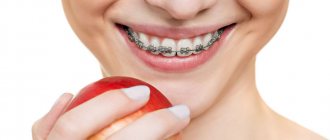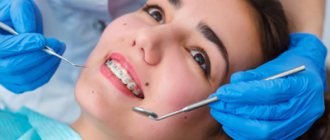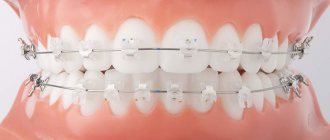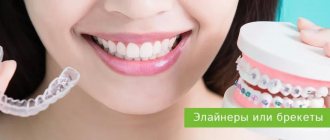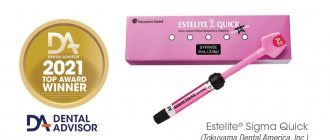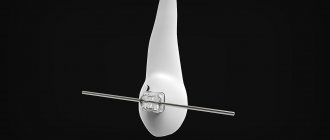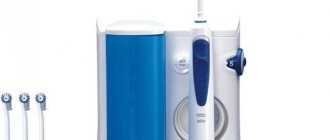Article navigation:
How did conventional metal braces appear? Types of metal braces. Ligature metal braces. Non-ligature metal braces. Vestibular and lingual metal braces. Cost of installing conventional braces. Pros and cons of metal braces. Myths about metal braces. Correction period for metal braces. Caring for conventional braces. How to eat when conventional metal braces are installed.
A healthy and beautiful smile attracts the attention of others and causes admiration. However, not everyone can boast of such a gift from nature. A person’s asymmetry also affects the teeth, which leaves an imprint not only on beauty, but also on health. Therefore, malocclusion must be corrected.
Today, the field of bite correction in dentistry is developing dynamically. New braces systems are appearing that are of high quality, almost invisible and aesthetic. Despite this, many patients still use metal braces for treatment. To understand patient preferences and their choice in favor of classic and more visible designs, it is necessary to understand the pros and cons of the metal system.
A brief excursion into history
Metal braces can easily be called a classic for correcting malocclusion and correcting defects in the dentition. Metal braces were first proposed by the American orthodontist Edward Engel. At that time, they were made of metal; the design itself was bulky and quite uncomfortable to wear, it rubbed the mucous membranes and caused a lot of problems in daily life. For many decades, orthodontists used such massive structures and could not offer an alternative option to their patients. Modern orthodontics offers a variety of systems that differ significantly in size, and some remain completely invisible, but metal braces have still not lost their popularity and are still superior to other options in terms of strength and effectiveness.
ITALY
In a country where almost every activity is turned into an art, even metal braces are made attractive and very comfortable. And if we take into account the love of Italian manufacturers for the use of the latest technologies in the manufacture of orthodontic structures, then a rather attractive image emerges of a braces system that will make your smile perfect without causing much inconvenience.
SIA Orthodontic
The company began its activities in 2000. Many models of this manufacturer of brace systems are distinguished by innovative elements that provide patients with increased comfort while wearing corrective devices. For example, Evolution metal braces have a rounded shape and low profile, which minimizes discomfort during treatment and shortens the period of adaptation to the system. And Crystal ceramic devices have a special mesh base, which ensures a tighter fit of braces to the surface of the teeth. The prices for SIA Orthodontics braces are reasonable, but so far the products of this brand are not so often found in Russian clinics.
Types of metal braces
The main feature and difference of a metal orthodontic bracket is the use of a metal alloy for the manufacture of brackets. The budget option uses an alloy of nickel, chromium and cobalt, while a more expensive alternative involves making plates for attachment to teeth from medical steel, titanium, and sometimes even gold.
Iron plates, that is, brackets that are attached to the teeth, are a feature that unites various metal brace systems, but otherwise they differ depending on the type of structure:
- Based on their location in the oral cavity, they are divided into vestibular and lingual;
- according to the method of fastening the power arc in the bracket locks - ligature and self-ligating.
Each subspecies has its own characteristics, positive and negative characteristics.
Fact #2 - The type of wire used for braces was invented by NASA.
One thing you might like is that the wire used for braces was created by none other than NASA!
Dr. Engle's vision was modern, but gold braces were also expensive. The field of orthodontics took a giant leap when NASA developed a metal alloy called nickel-titanium in 1959. While they created this heat-resistant metal for the space shuttle, it is also ideal for making thin, flexible wires that could maintain their shape after being bent and attached to a patient's teeth.
Metal ligature braces
This is a classic type of metal braces, characterized by its affordability from a financial point of view and efficiency in comparison with other designs. They are universal and suitable for correcting the most serious complications.
The system got its name due to the presence of ligatures - special elastic bands or wires that fix the power arc on the jaw. This arch is made with shape memory and, after fixing it on a curved dentition, it strives to return to its original position and moves the teeth behind it with force. Thus, ligatures are a kind of intermediary that holds the arch and transfers pressure from it to the bracket, and then to the tooth.
During long-term treatment, the dentition has to be affected with different forces, and ligatures make it possible to fully control the process of correcting a crooked bite, periodically change the type of fixation of the power arch by changing the degree of tension of the rubber bands: from less force with passive fastening at the very beginning of treatment, gradually increasing the degree of influence to active type of fixation at the final stage. This approach provides quick and effective treatment, and to add variety to the drab everyday life, the patient can choose colored and bright rubber bands.
However, one cannot fail to mention the significant disadvantages:
- difficulty maintaining oral hygiene;
- the need for regular correction by an orthodontist (on average once a month);
- ligatures are stained by food products and break;
- complex and time-consuming installation of the system.
E-arch: the first modern braces
The design looked like this: rings were attached to the chewing molars, and an arch was laid along the dentition. This system was made from a gold alloy and had sufficient rigidity to withstand increasing bending. At the ends of the arc there were threads for screwing on the nut, which made it possible to gradually expand it. With the help of the E-arch it was possible to correct only the inclination of the teeth vestibular, but it was impossible to influence the position of each of them. Experimenting, Engle placed rings on other teeth using vertical tubes. A pin was attached to the tube, soldered to the arch, with which it was possible to change the position of an individual tooth.
Regulating this device required considerable effort, and the inventor subsequently abandoned it. The E-arch remains only in memories as the first design in the modern history of braces. Completely correcting dentition braces appeared later.
Metal non-ligature braces
Metal non-ligating braces are also called self-ligating. Orthodontists often present them to patients as a new model that will make the process of correcting the bite simple and comfortable not only for the doctor himself, but also for patients. Their cost is 2-3 times higher than the price of classic ligature models, but manufacturers explain it by the following factors:
- less pain during treatment and a soft, uniform effect on the dentition;
- the overall treatment period is shorter;
- there is no need to frequently visit a doctor for correction.
In practice, such advantages are categorically disputed by dentists:
- the doctor cannot influence the course of treatment and choose the type of fixation (active or passive). To adjust the force on the jaw, you will need to change the arches;
- Considering the previous fact, the treatment period cannot be shorter. The only exceptions will be minor defects.
Some manufacturers offer ligature-free metal braces, the brackets of which are equipped with wings (hooks) for ligatures. However, by choosing this type of orthodontic system, the patient completely eliminates the basic idea of ligature-free structures - an invisible and lightweight design.
However, self-ligating braces are still in demand among patients, who explain their choice with such advantages as:
- compactness and neatness;
- simplified installation;
- soft and uniform movement of the dentition;
- simplified oral care;
- easy adaptation.
Tape arch
Continuing his research, Engle replaced the tube with a rectangular groove. Now the design looked like this: a ribbon arc made of gold alloy was installed in the grooves and was secured with pins. This system became quite widespread in the world, as it had undoubted advantages over the one that existed before:
- small in size;
- quite elastic;
- provided a visible effect.
But this design of braces also had its weak point: with its help it was impossible to influence the position of the tooth root precisely because of its good elasticity.
By localization – vestibular and lingual
When it comes to the type of fastening of metal braces to the dentition, there are 2 types: vestibular and lingual.
The vestibular metal brace system is the most common today. This type of fixation is done on the outside of the tooth, making them very noticeable. Dental care and installation of the vestibular system is much simpler. Almost all orthodontic manufacturers produce metal vestibular braces, and their price is the lowest compared to other materials and type of fastening. This fact explains its high prevalence among patients, as well as its almost universal use by orthodontists. That is, the patient has a wide choice of dental clinics and doctors to correct the bite.
The lingual brace system is completely invisible - it is installed on the inside of the tooth. The second name for such braces is invisible. Among the advantages are:
- less fragility during active sports;
- suitable for musicians who play wind instruments, because the locks do not cling to the instrument;
- recommended for the treatment of crowded dentition, micrognathia (small jaw size), as well as low height of the crown of the tooth.
However, lingual systems are not without disadvantages, which often become an obstacle to the patient’s journey:
- low prevalence, which means that not all doctors know how to work with such orthodontic brackets;
- high cost compared to other types;
- a long adaptation period, which takes on average 1-1.5 months;
- increased salivation, changes in diction, possibility of injury to the tongue;
- complexity of manufacturing, often only using individual casts;
- limited viewing angle, which explains the complexity of installation;
- long correction period, which is partly due to the time it takes to manufacture and deliver the system from abroad;
- the need to follow a strict diet and complicated care due to the high risk of structural failure.
Important! While manufacturers are constantly developing new materials and alloys that are less noticeable on the teeth for vestibular systems, only metal is used to make lingual systems. The braces are still invisible and there is no need to use other materials that increase the cost.
It does not matter which system is chosen: vestibular or lingual - the patient will always be able to choose ligature and self-ligating systems. However, ligature braces are still the most common.
GERMANY
The quality of many products made in Germany is admirable. Filigree precision, meticulous attention to detail, and the use of modern materials are strong arguments for choosing braces from German manufacturers.
TOP-Service für Lingualtechnik GmbH
The company has been operating since 1997. It produces the famous Incognito lingual braces, which are attached to the inside of the teeth and are invisible to others. These devices are manufactured individually for each patient on fully automated equipment using unique technology, so their cost is higher than that of any other types of braces.
Forestadent
Manufacturer of the first self-ligating braces. Initially, she was engaged in the manufacture of jewelry, so her orthodontic designs are distinguished by their particularly precise parameters and elegant design. Forestadent produces all types of braces, and their metal systems have been in demand among patients around the world for several decades. The excellent quality and effectiveness of Forestadent braces fully correspond to their high price.
Cost of treatment
The cost of manufacturing and installing metal braces is significantly lower compared to ceramic or sapphire systems, which is one of the most important issues when choosing an orthodontic design. The cost of the simplest braces, including installation, starts from 15-20 thousand rubles. A higher price is possible in the following cases:
- the need for custom manufacturing, as is the case with lingual ones;
- complex metal alloy;
- rare brand and country of manufacture;
- a large number of teeth in need of correction.
In this case, the patient must take into account that additionally regular visits to the orthodontist will be required for correction, and at the final stage, invisible retainers are installed to consolidate the achieved result.
Fact #3 - Braces are not just for straightening teeth.
While perfectly straight teeth are a wonderful aspect of braces, one of the main benefits is that braces secure the wearer's bite. If your upper front teeth overlap your lower teeth and the ridges of your molars do not touch, you have a perfect bite. Not many people can boast of this.
Braces are more than just cosmetic devices. Because they stabilize your bite, they also provide relief from a variety of health problems, including:
- Breathing problems;
- Problems with chewing and swallowing.
Pros and cons of choosing metal braces
Based on the information reviewed, you can weigh all the pros and cons of metal braces. If we talk about positive qualities, we highlight:
- high degree of metal reliability. Such structures are less likely to break and do not bend, provided they are made from high-quality copper alloy. Compared to metal braces, plastic or ceramic braces are more likely to break and the locks to come loose. Metal plates do not wear out, do not stain and retain their desired appearance for the entire period of bite correction;
- the ability to correct complex dental pathologies. A high-quality metal alloy provides maximum pressure on the teeth;
- short period of wearing braces. Due to the high pressure on the dentition, the correction is made faster, which means the patient quickly acquires a beautiful smile, compared, for example, with ceramics;
- low cost;
- easy maintenance and operation. The power arc and locks are not scratched or stained by food, and are resistant to temperature changes;
- the ability to choose the original shape of the locks. Manufacturers strive to make the correction period as comfortable and enjoyable as possible, so they are ready to produce colored rubber bands and locks of various shapes, which will be relevant for teenagers.
Speaking about the advantages, we must not forget about the disadvantages of metal braces, which can become an obstacle:
- metallic color. Such orthodontic structures are noticeable when talking and smiling, which significantly affects the appearance during the correction period;
- the likelihood of an allergic reaction to nickel present in the alloy. In this case, patients are offered the manufacture of titanium or gold-plated plates;
- protruding edges of the plates that rub the lips and mucous membranes of the mouth. However, the problem is easily solved by applying orthodontic wax to the sharp edges.
How to remove metal braces
Metal braces are removed after complete treatment. The procedure consists of several stages:
- a power arc is released from the locks;
- each bracket is removed individually with special forceps;
- soft polishing of tooth enamel is performed to remove residual orthodontic adhesive;
- teeth are coated with a remineralizing composition;
- Retainers are installed.
The last manipulation is necessary to prevent tooth displacement. Wire structures are fixed on the inner surface of the dentition; they need to be worn for the same amount of time as the correction lasted, or longer. You can replace fixed retainers with a mouthguard worn at night.
Truth or lie? Popular myths
Patients often believe myths that prevent them from achieving a beautiful and healthy smile. It is important to dispel such false statements:
1. “Metal braces look unsightly.” On the one hand, this statement is true. The metallic color and the bracket system itself attract the attention of others when talking. However, the dentist can offer lingual structures that remain completely invisible.
2. “Braces are only relevant for children.” Such beliefs are associated with the high prevalence of various correction methods among adolescents and schoolchildren. This is explained by the fact that the desire to have a beautiful smile is most in demand at a young age, and the treatment itself occurs faster during the period of active growth and mobility of teeth. However, a person should think about his well-being even after 30 years, because healthy and straight teeth are not only a beautiful smile, but also the condition of the entire body as a whole.
3. “The treatment is painful.” Partially, this is true. The patient may experience some discomfort after a power arch tightening. However, the unpleasant sensations last only 1-2 days, after which the jaw adapts to the new conditions. Pain and itching in the gums go away on their own and, in rare cases, require medication.
4. “Fixed metal structures damage the enamel, which means they negatively affect dental health.” Before attaching the locks to the enamel, the patient undergoes complete treatment of carious changes and extensive diagnostics of the strength of the enamel. Based on the data obtained, the dentist assesses the risks of complications. Healthy enamel can withstand the load of the structure without damage, and maintaining oral hygiene and following the doctor’s recommendations on nutrition eliminate the risk of caries in the areas of the tooth around the clasps.
To summarize, we can conclude that metal braces have many advantages. This is one of the most popular systems for correcting malocclusion. Moreover, their demand in the field of orthodontics is explained not only by their low cost, but also by the short treatment time, as well as the ability to correct complex defects.
Fact #4 - Smile like the Egyptians
The desire for straight teeth can be traced back even further than the 18th century in France, all the way to Ancient Egypt! Who knows whether the ancient Egyptians were aware of the health benefits given in the previous fact, or whether they simply wanted straight teeth for cosmetic reasons, but some mummies have indeed been found with temporary "braces." Archaeologists believe that animal intestines wrapped around the mummies' teeth, similar to modern braces, were an attempt to straighten crooked teeth.
Recommendations for the care and wearing of non-removable metal structures
Despite the fact that metal braces are considered one of the most durable, they require careful care. Due to the presence of a bracket, a power arc and elastic bands on the teeth, oral care is complicated. The patient will have to follow a number of rules:
- teeth are brushed after each meal to avoid pieces of food getting stuck in the structure;
- A toothbrush alone is not enough to maintain oral hygiene. Additionally, you will need a set of specialized brushes, dental floss, and an irrigator;
- Once every 2-3 months, professional teeth cleaning in a dental clinic is recommended to remove plaque in hard-to-reach places;
- You may need orthodontic wax if the edge of the plate protrudes and rubs the mucous membrane.
Fact #8 - You need to bust some myths!
Sometimes myths prevent us from making the right decision and putting on braces. Destroy the myths that prevent you from taking a step towards a beautiful smile?
- You will be able to engage in any sport without restrictions;
- You will be able to play musical instruments effectively, including those that use your mouth;
- Staples do not beep in metal detectors;
- The brackets do not interfere with radio signals;
- The brackets are not magnetic;
- It is impossible to “lock” braces by kissing another person with braces!
Ugh! Nobody wants to have problems with airport security, give up a hobby or kissing. Good news!
Nutritional Features
After installation of metal braces, patients are advised to follow a simple diet. Metal braces are securely glued to the tooth, and the metal is not subject to staining, so more foods are allowed in the diet compared to “white” aesthetic braces. However, in a complex design, pieces of food can get stuck, which can be difficult to remove. Patients are advised to avoid viscous foods (taffy and chewy caramel), hard foods (nuts, seeds) due to the risk of the plates coming off or breaking the arc.
In the case of installing a lingual system, there are more restrictions due to the fragility of the structure, complicated repairs and maintenance.
How is treatment with metal braces performed?
Fixed orthodontic appliances apply constant pressure to the teeth, causing them to gradually move into the desired position. The arch plays a significant role in this process: at first it repeats the irregular shape of the teeth, but tends to return to its original position, thanks to which it smoothly corrects the bite. After each correction, the doctor changes the archwire to a thicker one to increase the pressure.
Let's look at why metal braces straighten teeth faster. The main quality of a metal system is its strength, and it does not really matter what metal is used in the braces. Due to the force of pressure, the teeth move faster and the treatment period is reduced. If the patient is faced with a choice between sapphire or metal braces, he must understand: although the sapphire design looks attractive, it will take a little longer to wear due to the fragility of the material.
So how long do you wear metal braces? Orthodontists call the average treatment period 1.5 - 2 years, but everything, of course, depends on the clinical case. The minimum period is 1 year for mild crowding of teeth, the maximum is about 3 years.
Other ways to straighten teeth
It should be noted that braces
– is not the only remedy that can have an effect on teeth straightening.
The following inventions are widely used in dentistry:
- Aligners or aligners.
They are polymer plates of transparent color that follow the shape of the dentition. This is an individual product for use, which is made individually for each patient. The main disadvantage of such an invention is its high cost. They have been used for more than a year, and they should be replaced every second week.
- Veneers.
This remedy is very effective for the most minor defects (dental gaps, slight curvature). They tend to hide imperfections rather than eliminate them. However, after just 2 weeks, the teeth acquire an aesthetic appearance.
This article is for informational purposes only, please consult your doctor for details! Ask your doctor about contraindications and side effects.
Prices for braces in our clinic
The price of a braces system consists of several components:
- type of orthodontic structure
- material from which the braces are made (metal, ceramic, sapphire)
- manufacturing company
INTAN Implantation and Dentistry Centers offer an objective price/quality ratio for dental correction in St. Petersburg. Our policy is honest, low prices , which means you won’t find hidden fees or fine print in the contract.
In addition to the above factors that influence the final cost of orthodontic treatment, the price formation is influenced by the initial condition of the patient’s oral cavity, the need for preliminary preparation, and the frequency of correction during treatment.
You can consult a dentist about the details of installing a braces system, who will offer several options that are suitable specifically for your situation. To avoid problems, it is better to make the final choice together with your doctor.
Fact #10 - One in four million
Going through a big change, such as getting braces, can sometimes make people feel lonely or self-conscious. Although there is nothing wrong or awkward in taking care of your smile. Why ? Because FOUR MILLION other people are wearing braces right now and that's just in our country!
The American Association of Orthodontics reported that four million people also have braces this minute. Not only are millions of people in search of a healthier, more beautiful smile, but about a million of these orthodontic patients are adults over the age of 18.
Be healthy, destroy bad myths and smile at good ones!
